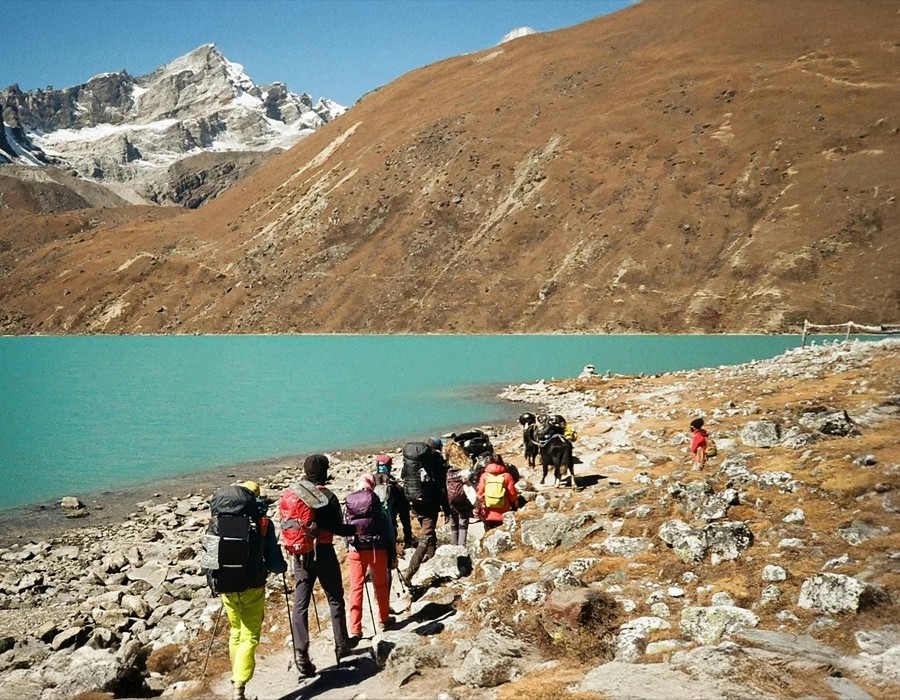The Gokyo Lake Trail is one of the most breathtaking treks in Nepal. Hidden in the heart of the Himalayas, it offers travelers an experience of remote trails, glacial lakes, and panoramic mountain views. Along the way, the scenery changes from lush forests to rocky slopes, and finally to turquoise high-altitude lakes. Each step provides a closer connection to the natural beauty and serene atmosphere of the Everest region.
Majestic High-Altitude Lakes
The highlight of the trek is the series of glacial lakes in Gokyo. Gokyo Ri, located nearby, provides a vantage point to see these sparkling lakes against the backdrop of the world’s tallest peaks, including Everest, Lhotse, and Cho Oyu. The lakes’ turquoise waters reflect the surrounding mountains, creating a scene that feels almost magical. Visitors can walk along the lakeshores, enjoy the peace, and capture the perfect photograph.
Remote Trails and Scenic Paths
The Gokyo Lake Trail passes through some of the most isolated paths in the Everest region. The route goes past Sherpa villages, rhododendron forests, and alpine meadows. Travelers experience the quiet of the mountains, away from crowded trails. Traditional stone houses, prayer flags, and small monasteries dot the villages, giving a glimpse into the local culture and lifestyle. The trek offers a combination of adventure and tranquility that few trails in the world can match.
Trek Statistics
The Gokyo Lake Trek is considered moderately challenging. The average duration is 8–12 days, depending on the pace and itinerary. The total distance covers approximately 110 kilometers (68 miles). The maximum elevation is 5,357 meters (17,575 feet) at Gokyo Ri. Trekkers encounter steep ascents, high passes, and uneven terrain, making it suitable for those with average to good fitness. The trail’s remote nature requires proper preparation and acclimatization to enjoy the experience safely.
Flora and Fauna
The trek passes through varied ecosystems. Lower sections feature rhododendron and pine forests, which bloom beautifully in spring. Higher elevations transition to alpine meadows and rocky slopes, where hardy shrubs and mosses grow. Wildlife such as Himalayan monals, snowcocks, and occasionally musk deer can be spotted along the trail. The crisp mountain air, combined with the sounds of nature, creates a refreshing and peaceful trekking experience.
Local Villages and Hospitality
Along the Gokyo Lake Trail, small Sherpa villages provide accommodation in tea houses and lodges. These simple lodges offer warmth, basic meals, and a chance to experience local culture. Traditional dishes like dal bhat (lentils with rice), noodles, and momos (dumplings) are commonly served. Interacting with villagers allows travelers to learn about Sherpa traditions, local festivals, and mountain life, making the journey more meaningful.
Best Time to Trek
The best seasons for the Gokyo Lake Trek are spring (March to May) and autumn (September to November). Spring brings blooming rhododendrons and pleasant weather, while autumn offers clear skies and spectacular mountain views. Winter is cold, with potential snow on higher trails, and summer coincides with the monsoon, which can make paths slippery. Choosing the right season ensures safety, clear views, and an enjoyable trekking experience.
Conclusion
The Gokyo Lake Trail is a unique Himalayan adventure. From remote villages to high-altitude lakes and panoramic mountain views, every part of the trek offers something extraordinary. The combination of nature, culture, and challenge makes it a must-do for trekkers seeking a rewarding and peaceful Himalayan experience. Standing at Gokyo Ri, overlooking the turquoise lakes and towering peaks, leaves a lasting impression and a deep connection to the beauty of Nepal’s Everest region.





Comments